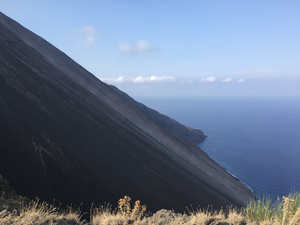Rock mass Fracture and Forecasting across time and Space - Philip Benson (University of Portsmouth, UK) - 30 maggio ore 11:00 Aula Ruffiniu
Da: Martedì 30 maggio 2023 ore 11:00
Fino a: Martedì 30 maggio 2023 ore 12:00

Seismicity has long been used to monitor volcanoes and active volcanic areas. In these regions, rising magma stresses the overlying rock to open (or reopen) conduits for fluid and gas flow. The fracturing and ensuing fluid-flow generates a range of seismicity frequently characterised by their spectral properties. These include Volcano-Tectonic (VT) events generated by rock fracture, Long Period (LP) seismicity generally interpreted as indicators of fluid migration, and Hybrid events characterized by a high frequency (VT-like) onset and low frequency (LP-like) coda. In many cases these data are reliable precursors to eruptions after extended repose (volcanoes that have been quiet for 100 years or more), and are frequently detected weeks or months before an eruption. For some years the detection of LP events was heralded as a new and more accurate forecasting (warning) method directly linked to fluid movement; however, this has proven inconclusive. To decipher these signals, and better constrain their physical generation mechanisms, laboratory rock physics experiments simulating these different seismic sequences have been developed.
Here, I present data from triaxial rock deformation experiments collected over 15+ years and from a range of rock types and pressure/temperature conditions. Collectively, they suggest that Hybrid events are more likely to be generated when fluid is present, and that LP events are enhanced by elevated temperature conditions due to localized fluid phase change. However, recently published work has now also shown that a common low-cohesion volcanic sediment from Campi Flegrei caldera (Italy) produces Long Period and low frequency seismicity whilst undergoing deformation in dry conditions rather than solely fluid-saturated conditions, with implications for interpreting upper edifice stability and hazard from seismic sequences. New research is now planned to finally extend the forecasting methods that often us compressional data to tensile fracture mechanics, and using new brittle-plastic rock physics models.
The Speaker: Philip Benson (University of Portsmouth, UK)
Philip Benson is a geophysicist working across the interface of laboratory rock physics, seismology, and volcano-tectonics. His research uses high pressure hydraulics to simulate fracture and faulting in shallow crustal rocks, and how these fractures interact with crustal fluids, to better constrain volcano eruption forecasting methods and understand earthquake triggering.
On site: h. 11:00 Aula Ruffini, DST
Remote: via webex at this link
Contacts: geoseminar.dst@unito.it





